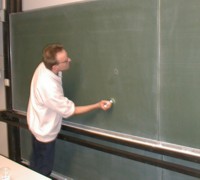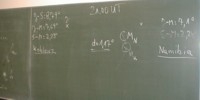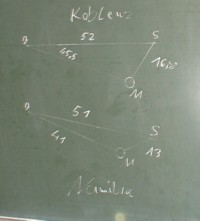Internet Project
Simultaneously Photographing of the Moon
and Determing its Distance
Evaluation
First Challenge: Proper motion of the moon
- Try to "see" the proper motion of the moon by comparison of two or more
pictures taken by the same observer.
- Determine the respective positions of the moon and calculate the related
angular difference.
- Calculate from this value the time the moon needs for a complete
circulation that means try to determine the apparent sideral periode of the
moon.
- What are the reasons for the surprisingly large difference to the true
value?
Second Challenge: First Parallax Effect
You may try to make the moon's parallax visible by combining simultaneous
pictures from Bulgaria and Germany. It is not obvious but it is possible to
find it!
Meanwhile, you may try to combine pictures from Bulgaria and
Tenerife. The moon's parallactic displacement has become more obvious:
Going
from East (Bulgaria) to West (Tenerife) we see the moon moving towards
Jupiter that means, in eastern direction!
Here are some of my solutions:
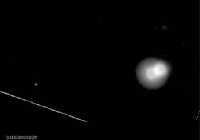
|
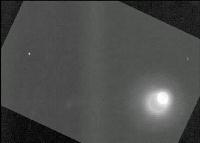
|
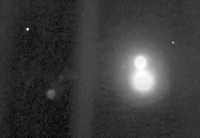
|
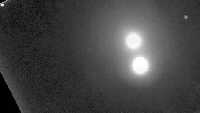
|
| Bulgaria and Tenerife, 21.00 UT
| Bulgaria and Koblenz, 21.00 UT
| Koblenz and Namibia, 21.00 UT
| Süderdeich and Namibia, 22.30 UT
|
I've got them by the following procedure:
- Scaling both of the pictures so that Jupiter and Saturn have the same
linear distance.
- Rotating one of the pictures so that the angle between the bottom line and
the straight line from Jupiter to Saturn is the same in both pictures.
- Linear translation of one of the pictures so that Jupiter has the same
pixel coordinates in both pictures.
- Finally, adding both of the pictures.
You can comprehend this procedure using any image processing software or,
respectively, by using a photocopier and putting the pictures on top of each
other so that Jupiter and Saturn coincide on both pictures.

Stereo picture of the moon as seen from Süderdeich and Namibia, December
9th, 2000, 22.30 UT
(You can see the sterographic effect by 'parallel locking', most easily
donne with the help of stereo glasses.)
(I hope I can combine a better stereo picture, soon!)
Detailed Problems (under construction!)
The following problems serve as hints for the evaluation of our pictures. You
should try to solve them by yourself. Nevertheless, you can find (at least
soon!) the answers in an additional
document.
- Find the exact geocentric positions (i.e. rectascension and declination)
of Jupiter and Saturn due to our observation times.
- Look for daily ephemerides in an astronomical almanach and interpolate!
- Alternatively, use an astronomical computer program!
Due to the large distance to the planets, their topocentric positions are the
same, with sufficient precision.
- Determine the related angular distances of the planets!
- You can measure these distances with the original slides of your
own by measuring the linear distance of the planets on the slide and taking
into account the focal length of your camera.
- Alternatively, you can derive these distances from the positions
determined above.
- Try to use the theorem of Pythagoras.
- For correct calculation, you will need some spherical trigonometry.
- With the known angular distance of Jupiter and Saturn, determine the
scale (in angle per pixel, for instance) of the pictures.
- Now you can measure the angular distance between the moon and the
planets.
- Determine the angular distance of the moon's positions as observed from
different locations.
There are different possibilities to do that:
- Construct scaled drawings with ruler and compasses.
(For instance, you may project the slides at the wall. The following pictures
may give you an impression of what we did in Koblenz.)
- Print different pictures to the same scale and put them together so that
the planets cover on both pictures.
- Calculate from the angular distances determined above and the
planets's coordinates the topocentric coordinates of the moon. Then, the
parallactic displacement of the moon can be calculated in the same way as
above.
- Determine the distance between different observers as muliples of the
radius of the earth. There are, again, three possibilities:
- Use the pictures of the earth contained in the
main document.
- Measure the distance with the help of a globe and a piece of a string.
- Calculate the distance from the geographic coordinates of the locations.
The measures got by the different procedures will not correspond exactly. Only
the first procedure will give you the distance as seen by the moon at
that moment!
- From the parallactic displacement of the moon and the the distance
between the related locations calculate now the distance of the moon as a
multiple of the earth's radius!
back to the main page
back to the January 6th page
back to the January 9th page
back to the March 1st page
back to the March 29th page
last update: January 10th, 2020









